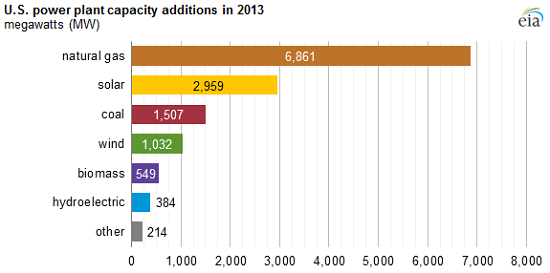 Alternative energy sources made for a good showing of new power-generating capacity added last year. This report from the U.S. Energy Information Administration (EIA) shows more than half of the utility-scale power generating capacity added last year came from natural gas-fueled plants, with solar accounting for another 22 percent – a significant increase from just 6 percent in 2012. Wind also accounted for another 8 percent of capacity added.
Alternative energy sources made for a good showing of new power-generating capacity added last year. This report from the U.S. Energy Information Administration (EIA) shows more than half of the utility-scale power generating capacity added last year came from natural gas-fueled plants, with solar accounting for another 22 percent – a significant increase from just 6 percent in 2012. Wind also accounted for another 8 percent of capacity added.

Natural gas capacity additions were … 6,861 MW … added in 2013, compared to 9,210 MW in 2012. The capacity additions came nearly equally from combustion turbine peaker plants, which generally run only during the highest peak-demand hours of the year, and combined-cycle plants, which provide intermediate and baseload power.
Nearly 60% of the natural gas capacity added in 2013 was located in California. The state is facing resource adequacy concerns as well as the need for more flexible generation resources to help complement more variable-output renewable resources, particularly solar, being added to the system.
Solar photovoltaic (PV) added 2,193 MW of capacity in 2013, continuing the trend of the past few years of strong growth, helped in part by falling technology costs as well as aggressive state renewable portfolio standards (RPS) and continued federal investment tax credits. Nearly 75% of the capacity added was located in California, followed by roughly 10% in Arizona.
While wind’s numbers in 2013 were only one-tenth of what it did in 2012, (1,032 MW in 2013 compared to 12,885 MW in 2012), EIA attributed this to producers rushing to take advantage of the federal production tax credit at the end of 2012.

